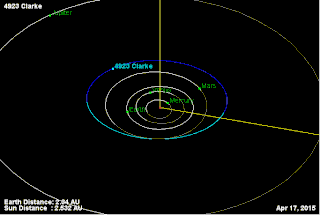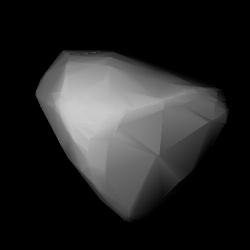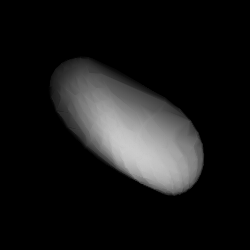Related Research Articles
Lumen is a carbonaceous asteroid from the intermediate asteroid belt, approximately 130 kilometers in diameter. It is an identified Eunomian interloper.
Brett James Gladman is a Canadian astronomer and a full professor at the University of British Columbia's Department of Physics and Astronomy in Vancouver, British Columbia. He holds the Canada Research Chair in planetary astronomy. He does both theoretical work and observational optical astronomy.
2934 Aristophanes, provisional designation 4006 P-L, is a carbonaceous Veritasian asteroid from the outer regions of the asteroid belt, approximately 22 kilometers in diameter. It was discovered during the Palomar–Leiden survey in 1960, and later named after ancient Greek dramatist Aristophanes.

4923 Clarke, provisional designation 1981 EO27, is a stony background asteroid from the inner regions of the asteroid belt, approximately 3.5 kilometers (2.2 miles) in diameter. It was discovered on 2 March 1981, by American astronomer Schelte Bus at the Siding Spring Observatory in Australia. The spheroidal S-type asteroid has a rotation period of 3.14 hours. It was named after British science fiction writer Arthur C. Clarke. On the same night, Schelte Bus also discovered 5020 Asimov.

251 Sophia is a stony background asteroid from the outer regions of the asteroid belt. It was discovered on 4 October 1885, by astronomer Johann Palisa at the Vienna Observatory in Austria. The S-type asteroid (S/L) has a rotation period of 20.2 hours and measures approximately 28 kilometers in diameter. It was named after Sophia von Seeliger, wife of German astronomer Hugo von Seeliger (1849–1924).
Aletheia is a very large main-belt asteroid that was discovered by German–American astronomer Christian Peters on June 28, 1886, at Litchfield Observatory, Clinton, New York. The dark and heterogeneously composed X-type asteroid contains primitive carbonaceous materials, responsible for its low albedo of 0.04. Aletheia measures about 185 kilometers in diameter and belongs to the largest asteroids of the main-belt. It has a semi-major axis of 3.1 AU and an orbit inclined by 11 degrees with a period of 5.55 years.
Padua is a main belt asteroid that was discovered by Auguste Charlois on 17 March 1893 in Nice. It was named after the city of Padua, near Venice, Italy.

1743 Schmidt, provisional designation 4109 P-L, is a dark background asteroid from the inner regions of the asteroid belt, approximately 19 kilometers in diameter. It was discovered during the Palomar–Leiden survey on 24 September 1960, by astronomers Ingrid and Cornelis van Houten at Leiden, on photographic plates taken by Tom Gehrels at Palomar Observatory in California. The C-type asteroid has a rotation period of 17.5 hours. It was named for the optician Bernhard Schmidt.
Cora, provisional designation 1902 LK, is a metallic asteroid from the middle region of the asteroid belt, approximately 30 kilometers in diameter. It was discovered by American astronomer Solon Bailey at Harvard's Boyden Station in Arequipa, Peru, on 30 June 1902. It was later named after Cora, a figure in Inca mythology.
688 Melanie is a dark background asteroid from the central regions of the asteroid belt. It was discovered by Austrian astronomer Johann Palisa at the Vienna Observatory on 25 August 1909. The carbonaceous C-type asteroid has a rotation period of 18.9 hours and measures approximately 42 kilometers in diameter. Any reference to the origin of the asteroid's name is unknown.
716 Berkeley is a background asteroid from the central regions of the asteroid belt. It was discovered by Austrian astronomer Johann Palisa at the Vienna Observatory on 30 July 1911. The stony S-type asteroid has a rotation period of 15.6 hours and measures approximately 21 kilometers in diameter. It was named after the city of Berkeley, California, where the discoverer's colleague Armin Otto Leuschner (1868–1953) was the director of the local observatory.

720 Bohlinia is a minor planet orbiting the Sun that was discovered by Franz Kaiser, a German astronomer in 1911. It is named for Swedish astronomer Karl Petrus Theodor Bohlin, to mark his 65th birthday. He had worked on the orbits of asteroids.

776 Berbericia is a minor planet orbiting the Sun. A main-belt C-type asteroid, it was discovered on 24 January 1914 by astronomer Adam Massinger at Heidelberg Observatory in southwest Germany. It was named by Max Wolf in honor of Adolf Berberich (1861–1920), a German astronomer. The spectra of the asteroid displays evidence of aqueous alteration.
814 Tauris is a dark and very large background asteroid, approximately 109 kilometers in diameter, located the outer regions of the asteroid belt. It was discovered on 2 January 1916, by astronomer Russian Grigory Neujmin at the Simeiz Observatory on Crimea. The carbonaceous C-type asteroid has a longer-than average rotation period of 35.8 hours. It was named after the ancient name of the Crimean peninsula where the discovering observatory is located.

943 Begonia is a large, carbonaceous background asteroid, approximately 70 kilometers in diameter, from the outer region of the asteroid belt. It was discovered by German astronomer Karl Reinmuth at the Heidelberg Observatory on 20 October 1920 and given the provisional designations A920 UA and 1920 HX. The dark C-type asteroid (Ch) has a rotation period of 15.7 hours. It was named after the genus of popular houseplants, Begonia.
1155 Aënna, provisional designation 1928 BD, is an asteroid from the inner regions of the asteroid belt, approximately 11 kilometers in diameter. It was discovered on 26 January 1928, by German astronomer Karl Reinmuth at Heidelberg Observatory in southwest Germany. It is named for the astronomy journal Astronomische Nachrichten.
3290 Azabu, provisional designation 1973 SZ1, is a dynamical Hildian asteroid from the outermost regions of the asteroid belt, approximately 10–20 kilometers (6–10 miles) in diameter. It was discovered on 19 September 1973, by Dutch astronomers Ingrid and Cornelis van Houten at Leiden, and Tom Gehrels the Palomar Observatory. The asteroid has a rotation period of 7.67 hours. It was named after the former city district of Tokyo, Azabu.
3254 Bus, provisional designation 1982 UM, is a rare-type Hildian asteroid from the outermost region of the asteroid belt, approximately 32 kilometers in diameter. It was discovered on 17 October 1982, by American astronomer Edward Bowell at Lowell's Anderson Mesa Station in Flagstaff, Arizona. It is named after astronomer Schelte J. Bus.
1995 Hajek, provisional designation 1971 UP1, is a metallic asteroid from the middle region of the asteroid belt, approximately 13 kilometers in diameter.
1759 Kienle, provisional designation 1942 RF, is a stony background asteroid from the central regions of the asteroid belt, approximately 7 kilometers in diameter. It was discovered on 11 September 1942, by astronomer Karl Reinmuth at the Heidelberg-Königstuhl State Observatory in southwest Germany. The S-type asteroid has a longer-than average rotation period of 29.3 hours. It was named for German astrophysicist Hans Kienle.
References
- ↑ "Minor Planet Discoverers (by number)". Minor Planet Center. 29 October 2018. Retrieved 19 February 2019.
- 1 2 "Bobby Bus - IfA Faculty". IfA Faculty. Retrieved 24 March 2018.
- 1 2 "IRTF Contact List". IfA Faculty. 18 January 2018. Retrieved 24 March 2018.
- ↑ Bus, S., Binzel, R. P. Small Main-belt Asteroid Spectroscopic Survey, Phase II. EAR-A-I0028-4-SBN0001/SMASSII-V1.0. NASA Planetary Data System, 2003.
- ↑ Graham, Rex (1 May 1998). "Making an exceptional impact". Astronomy. p. 36.
- ↑ Schmadel, Lutz D. (2007). "(3254) Bus". Dictionary of Minor Planet Names – (3254) Bus. Springer Berlin Heidelberg. p. 270. doi:10.1007/978-3-540-29925-7_3255. ISBN 978-3-540-29925-7.